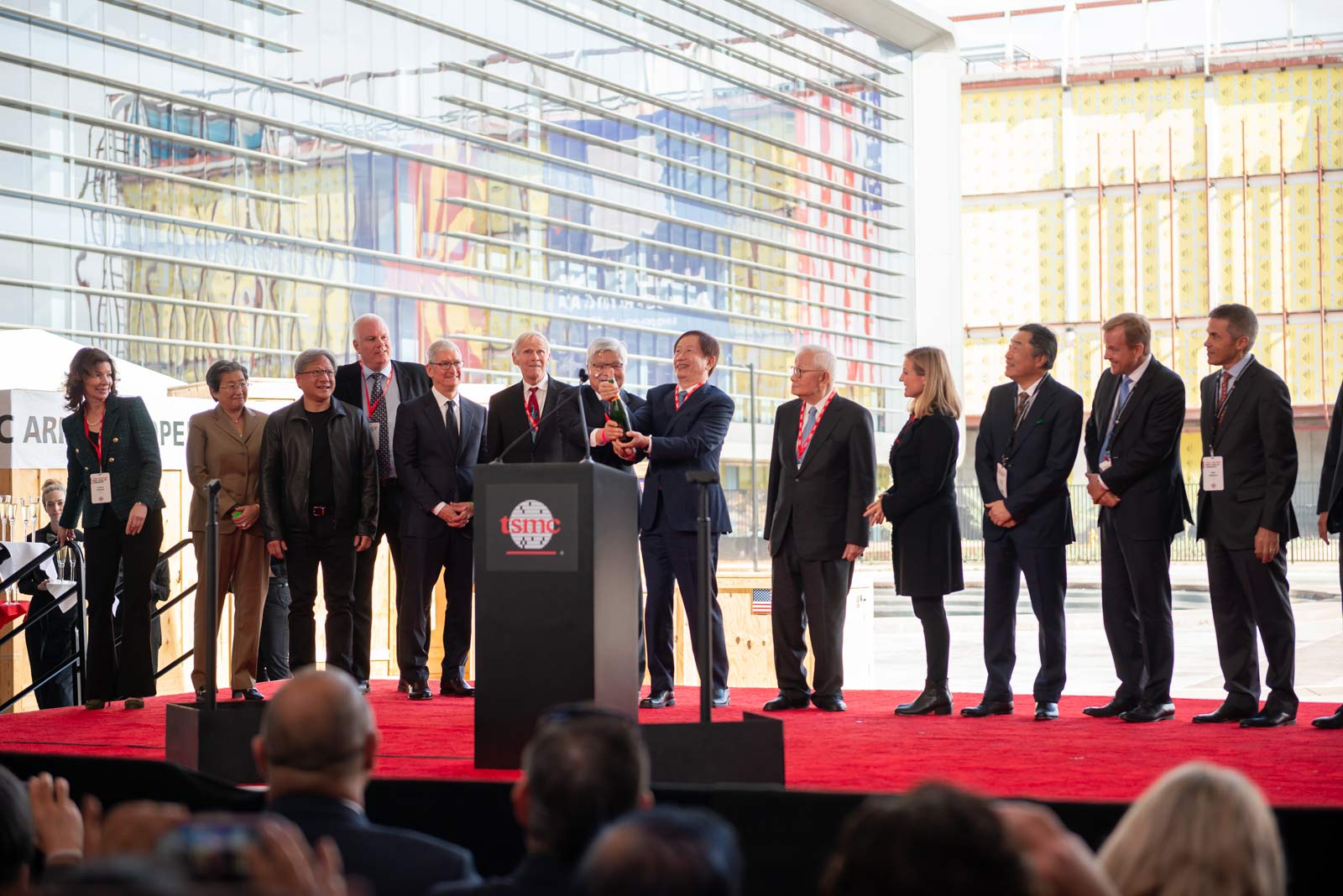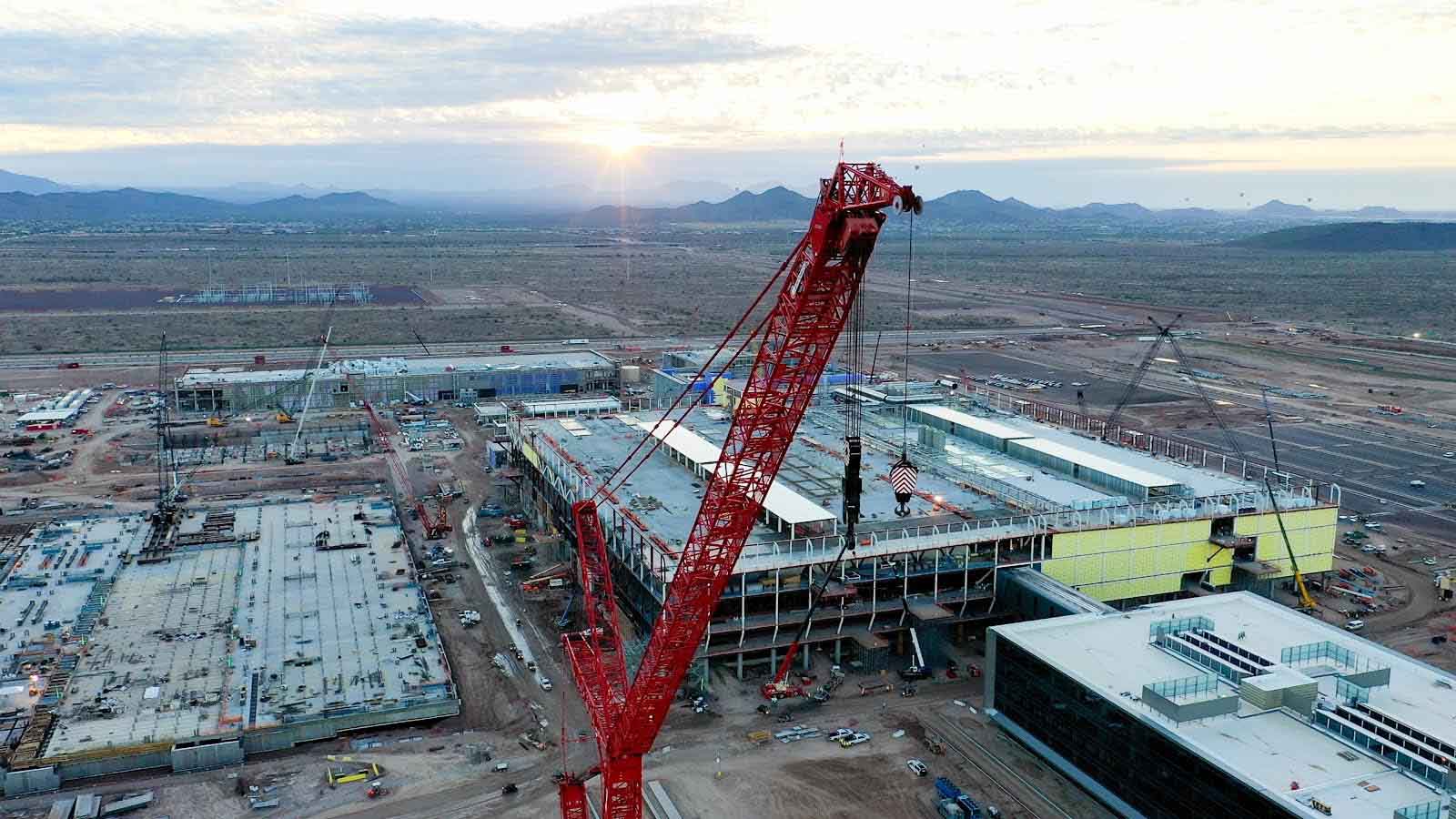TSMC's U.S. tool-in ceremony is over, what’s next?

Source:TSMC
On December 6, TSMC Fab 21 in Arizona became the star of the desert. President Biden flew in for the event, making it a benchmark case for Make in America. After the party, CommonWealth Magazine’s Elaine Huang made three observations on TSMC's new challenges.
Views
TSMC's U.S. tool-in ceremony is over, what’s next?
By Elaine Huangweb only
【Semiconductor Century Conversation|Morris Chang x Chris Miller】Book your seat: https://bit.ly/3Yd6IUv
December 6, 2:00 p.m., on the Fab 21 construction site in northern Phoenix, Arizona.
Introduced by TSMC Chairman D.Y. Liu, Biden, who had just walked around the construction site, walked onto the stage with his signature smile to a standing ovation.
It was an unprecedented event in the history of Taiwanese companies. In addition to the local governors and mayors, there were standing ovations from a number of $100 billion market cap corporate bosses, including NVIDIA CEO Jen-Hsun Huang, AMD CEO Lisa Su, Esmer CEO Nick Wen, and Apple CEO Tim Cook, the world's largest corporation.
This was just the first tool-in ceremony for TSMC's new U.S. plant.
"This is the first time that TSMC has publicly demonstrated its government relations capabilities," a foreign investment bank analyst exclaimed, "and it's a good job.”
Before the ceremony, TSMC gave Biden a big gift by announcing that it will increase its future investment in the Arizona fab to $40 billion, one of the largest foreign investment cases in U.S. history.
The second phase of Fab 21, which will produce 3-nanometer chops, will begin mass production in 2026 and will create 13,000 high-paying jobs in the area.
Under the sunny Arizona sky, three huge flags, the U.S. flag, the Arizona flag, and a curtain with a huge TSMC logo, had been hung.
"These are the most advanced chips on the planet, driving iPhones and MacBooks. ......" Biden said enthusiastically, "Who says America can't lead the world in manufacturing again?
This small gesture has become a warning sign to some Taiwanese - will the U.S. government sacrifice the interests of TSMC and even Taiwan for the sake of U.S. manufacturing?
Many people also noticed that in Biden's 10-minute speech, he did not mention "Taiwan" once.
Although Fab 21 will account for less than 10% of TSMC's revenue by 2026, people wonder if TSMC will continue to expand more advanced processes in the U.S. under pressure from the U.S. government, resulting in the "de-Taiwanization" that the nation fears most?
Key point 1: Do large customers want TSMC to move to the U.S.?
The attitude of large customers is crucial.
If customers are willing to pay for the high costs of production in the U.S., then the likelihood of TSMC's "de-Taiwanization" is much higher.
After all, TSMC founder Morris Chang has always told his employees that "TSMC can go through fire and water for its customers.”
Apple is TSMC's largest customer, accounting for 25% of TSMC's revenue.
In Apple CEO Tim Cook’s speech, he said he looked forward to expanding his partnership with TSMC in the coming years, "especially with the new, deeper roots TSMC is building in the U.S. We're planting a seed in the Arizona desert," he said, "and Apple is proud to help nourish its growth," and later tweeted that Apple would be Fab 21's largest customer.
In fact, it is widely believed in tech circles that TSMC's willingness to bring 4nm and more advanced 3nm processes to the US could not have happened without Apple's support.
The chairman of the National Development Council, Ming-Hsin Kung, who represents the National Development Fund as a board director of TSMC, also flew in to attend the ceremony.
Faced with the issue of de-Taiwanization, "How is it possible? The company's most advanced processes are still in Taiwan," explained Kung, "when TSMC's Arizona plant goes into production in 3nm in 2026, our 2nm is already in mass production.
AMD is looking forward to becoming a major customer of TSMC's two plants in Arizona," said Lisa Su, CEO of TSMC's second largest customer, in her speech.
The Tainan-born Su further explained, "Of course, we will use both TSMC's Taiwan and U.S. plants," she said, "and of course, it's good to have advanced manufacturing in the U.S." when asked about this on the sidelines.
Asked the same question, Jensen Huang of NVIDIA replied, "I don't think this plant can make all the chips needed in the U.S.," he said.
"I am confident that all the factories in Taiwan will be full," said the Tainan-born man, reassuring the people of his hometown.
 Fab 21 in Pheonix Arizona (Source: TSMC)
Fab 21 in Pheonix Arizona (Source: TSMC)
Key point 2: the “TSMC speed"
Regardless of how much capacity TSMC will build in the U.S. in the future, the "TSMC speed" has already shocked Americans.
"It took them only 20 months to build a state-of-the-art semiconductor plant in the desert," said the proud Singaporean-born Benjamin Loh, CEO of ASMI, a TSMC equipment supplier.
Given the labor, cost and efficiency in the U.S., "it's a miracle that TSMC can build this plant like this.
Challenges include the construction review process, the fact that 90% of workers needed to be recruited by local unions, and restrictions on working hours.
A TSMC executive on site admitted that Taiwan's science park model relied upon the government providing many facilities to incoming manufacturers. "Similarly, we are dependent on the Phoenix City government, and it's the first time they've built a semiconductor plant in the U.S. for a long time.”
However, Intel is building one of the largest semiconductor clusters in the U.S. in Chandler, Arizona, which is only a half-hour drive from Phoenix. Was it possible for TSMC to leverage their experience?
"We asked them a long time ago, and they said Chandler is Chandler and we are Phoenix, there is no interoperability," the executive said.
With an abundance of factory-building experience under his belt, CTCI Group chairman John Yu explained that it is relatively easy to build a factory in Taiwan. For example, even when not all of the design is completed, one can still apply for a license to start construction, but in the U.S. one must complete all the design before it can be reviewed and approved to start construction. The process is very time-consuming.
"I am very proud to see the real factory on site," said Yu, who flew to Phoenix to attend the ceremony.
Key point 3: The official end of the balance between TSMC and the United States
A foreign investment bank analyst said he watched the whole ceremony and felt that "TSMC is more pro-US than I thought.”
He pointed out that at the beginning of the US-China trade war, TSMC has been careful to maintain a balance between the US and China, for example, the first phase of the two new plants in China and the US are both with a monthly production capacity of 20,000 wafers, and the mass production is based on the "N-1" principle, which mean one generation behind Taiwan.
When TSMC's Nanjing plant mass-produced 16nm in 2018, Taiwan has already entered 10nm; when Fab 21 is expected to mass-produce 4nm (a minor revision of 5nm) in 2024, Taiwan has also entered 3nm.
Even when the $52 billion U.S. chip law was passed, despite the uproar, most in the industry expected that TSMC would not even apply for subsidies under the law, opting instead to receive subsidies from local governments.
This is because the CHIPS Act stipulates that grant recipients cannot invest in more advanced technologies than the 28nm process in China after 10 years, forcing companies to choose sides between the U.S. and China.
These concerns were shattered at the launch ceremony on the 6th.
TSMC announced that it will build a 3nm process in Fab 21 Phase II, and also announced the end of TSMC's China-US balancing act. TSMC is expanding its production in Nanjing with a mature 28nm process only.
Next, the first sentence of Cook's speech on stage revealed the mystery, "Special thanks to President Biden for signing the CHIPS Act, allowing more projects like (Fab 21) to come to fruition.”
TSMC's largest customer believes that TSMC will apply for subsidies under the CHIPS Act and lean on the U.S. In TSMC's November 14 response to the U.S. Department of Commerce, the company requested for amendments to the chip subsidy program, revealing its intention.
In the document, TSMC requested the U.S. government to relax the restrictions of the CHIPS Act to allow TSMC to expand the 16nm capacity of its Nanjing plant on the grounds that the technology is "already an outdated process.”
A foreign investment bank analyst believes that TSMC's attitude has changed, "It seems interested in getting the subsidies (from the CHIPS Act).
A TSMC executive did not deny that there was an interest in applying for subsidies.
In terms of the history of semiconductor development in Taiwan and around the world, TSMC's decision to locate its advanced process plants in the U.S. has ended Morris Chang’s pursuit in creating an entirely neutral, customer-oriented foundry model in the global semiconductor ecosystems. He is eventually forced to choose sides.
The larger strategic significance behind this is that the U.S. is determined to build its own manufacturing strength on national security grounds, not only with TSMC, but also with Intel and Samsung.
As the sun sets in Arizona and the orange sky envelops Fab 21 after the festivities, the U.S. now has its own agenda and TSMC is about to embark on a new round of challenges.
Have you read?
- Live from the US: TSMC Arizona transforms desert into oasis
- Taiwan’s chip future hanging on TSMC’s 2nd US go-round
- TSMC alone cannot rebuild the US semiconductor supply chain - Taiwanese Hidden Champions need to follow
Edited by Kwangyin Liu
Uploaded by Ian Huang






